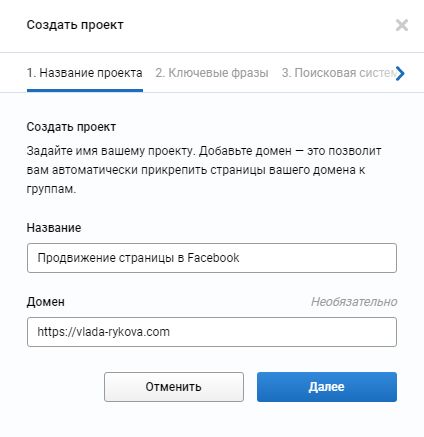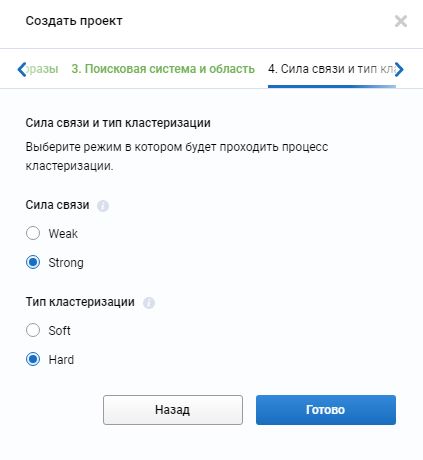What criteria does Google use to evaluate the quality of website content?
All search engines strive to ensure that information sites offer the highest quality content to the Internet audience. When texts are identified that do not meet the current requirements of analytic robots, search engines quickly respond to violations by imposing various penalties on resources.
Filling quality analysis is carried out using a wide range of methods and techniques. It is worth noting that it is still unknown what kind of analytical strategy is used by Google at the stage of researching the content of the site. This post will focus on learning the concepts that will help you optimize your content in 2018.
What should you focus on?
Today, Google primarily evaluates the following indicators of sites:
- content reading level;
- density of keywords, phrases;
- the number of promotional materials;
- speed of loading, functioning of web pages;
- uniformity of text content;
- language parameters (characteristics) of articles.
Current Analytical Methods 2018
1. Panda algorithm. This tool was launched back in early 2011. Since then, Panda has been repeatedly updated and modified. In January 2016, the algorithm was included in the basic analytical complex of Google.
The purpose of the functioning of Panda at the start is to search for low-quality and uninformative content. At the moment, Panda continues to fight against duplicate content, spam, but the mechanism of the algorithm has become more complex. This allows the system to carry out a comprehensive analysis of web-documents, as well as to lower the rating (position) of the “failed” sites in the shortest possible time.
In order not to fall under the Panda, use the following recommendations:
- create content with maximum technical and informational uniqueness;
- carefully check written articles for spelling and stylistic errors;
- semantic sufficiency of content is a parameter that will be monitored by Google in 2018 in the first place.
2. Density of keys and content, which is a 100% copy of the content structure of other thematic texts. Placing too many keywords in articles is an outdated optimization tactic. At one time, this method allowed the site to take high positions in search engines. Today he does not work.
The point is that content saturation with keywords is a strategy aimed not at improving the quality of an information product, but at meeting the initial requirements of search engines. Google is opposed to this tactic as it does nothing to improve the user experience.
It is also worth remembering that the system considers low-quality content that contains a minimum number of synonyms for keywords from the semantic core (SN).
Duplication of the content of texts posted on the web (publication of the so-called “vanilla” content on the site) has a similar (negative) effect on the ranking of sites in search engines. Texts that are characterized by the absence of not only novelty, but also the original presentation of the material, are perceived by the search engine as informational garbage.
Solving the problem: In the process of processing source texts with high search rankings, connect additional sources of information (interviews with niche experts, information taken from news portals, fresh data from conferences, seminars, and so on).
Lifehack: to automate the work with texts in new realities, I recommend using the new “Text Analytics” functionality from Serpstat.
For example, I took one of the most visited blog pages – “Facebook Page Promotion”.
1. First, create a project in Serpstat.
2. Enter a list of key phrases for analysis (you should have had them at the stage of collecting the semantic core).
If you do not have a list of keywords, again, Serpstat will help you.
- Look at what phrases your page is currently in the TOP, upload this list.
- Look at the list of Missed Phrases and upload this list too.
- Load both lists into the created project.
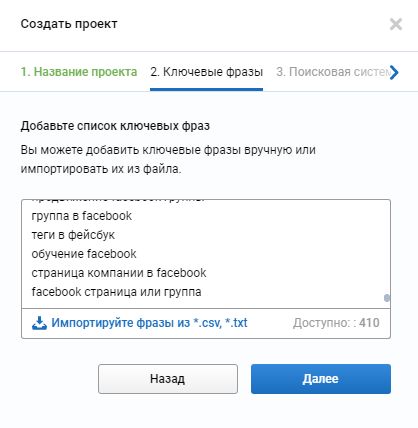
3. Select the search engine settings.
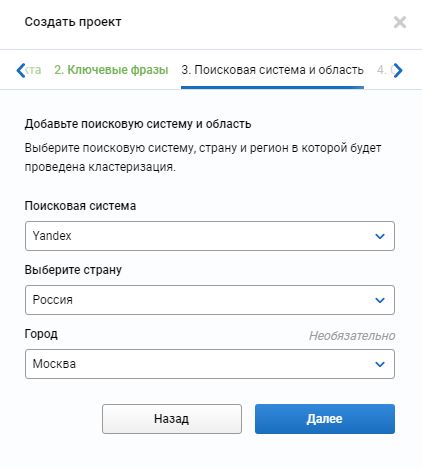
4. Strength of connection and type of clustering. On this issue, read more in the article – “Query Clustering”
5. After everything is clustered, click the “Text Analytics” button and select the clusters. I chose everything.
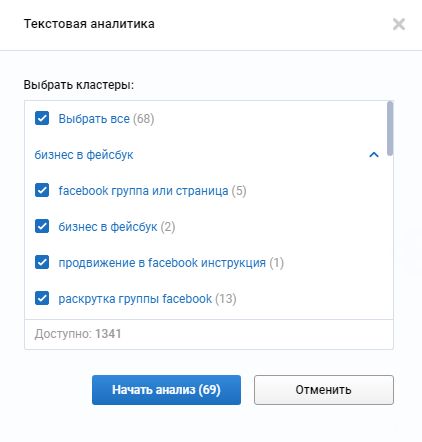
6. Further, in the context of each cluster, you can analyze your article by adding its url.

7. As a result, you will receive something like this report with recommendations on which words to include, which ones are spammed, and which ones are OK.
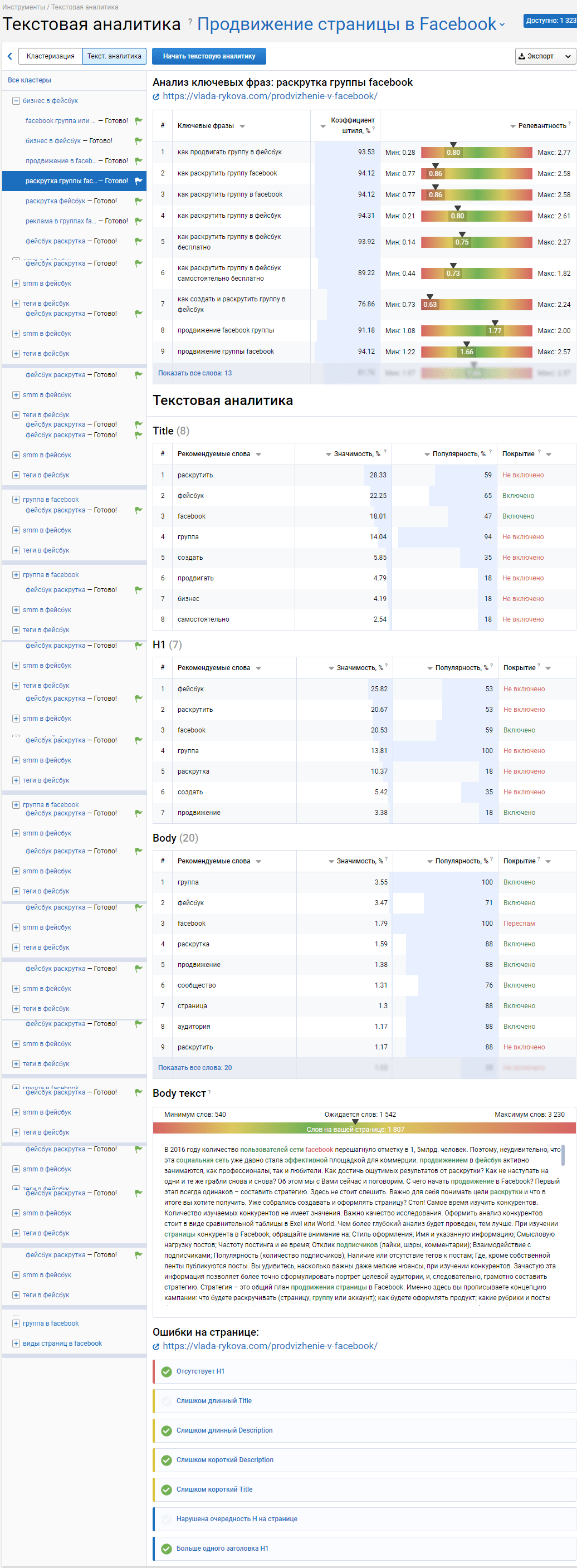
3. Advertising and Page Layout tool. Recent studies show that sites with a large number of advertising materials in 2016-2017 became less visited by users. Here we should recall the Page Layout algorithm, which was launched in 2012. It is necessary to focus on it even today.
Reference: Page Layout is a tool that lowers the positions of sites with a high density of advertising (it is usually placed at the top of the page, which entails a shift in the main content).
Solution:
- analyze the page, find out how much space it takes ads;
- if more than 30-40% of the space is allocated to it, then I would recommend reducing this figure to 20% (you should also pay attention to the number of pop-up ad units).
4. Download speed. This parameter is important for the target audience of the site. As well as for Google. The search engine does not want resources to be present in the results feed that would slow down the process of solving user tasks.
In the spring of 2010, the system added download speed to the list of key ranking factors. Today, sites that load more than 5 seconds may have higher bounce rates and fewer conversions.
5. Language options. Language monitoring allows search engines to detect and understand the intentions of Internet users. The ranking of web projects in 2018 will be based on the implementation of this particular procedure.
Let me remind you that in 2015 the system introduced the RankBrain algorithm, the purpose of which is to study the context, the essence of verbal structures located within information sites. The information obtained is subsequently used as part of the selection of the optimal algorithm for issuing relevant results.
One of the methods used by the search engine is the selection of language patterns that cause the formation of the most productive results, taking into account any user-specified query.
Conclusion
Analysis, as well as studying the features of the work of current algorithms, will help you not only competently optimize the content on the site, but also take the first positions in the search results. Good luck to you.
Internet marketing expert. Head of marketing agency MAVR.
Business degree “Master of Business Administration” (MBA).




